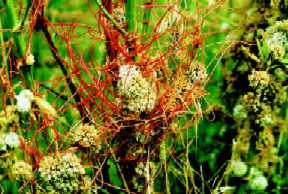Dodder

by Ted LeVan

by Ted LeVan
If you've ever visited the Baylands Nature Preserve in the springtime, you've probably seen one of the salt marsh's more unusual plants, Dodder, in full bloom. Dodder, a member of the Cuscutaceae family, is quite unlike the plants most people are familiar with (see source 5). It certainly doesn't have green stems and leaves like "normal" plants (see source 2). Much of the time it doesn't even have roots. Instead, it is suspended in mid-air through its attachments to other plants. In the salt marsh, Dodder grows as tangled bunches of orange stems. Its unusual appearance has given it a number of interesting nicknames: "beggarweed," "hairweed," and "strangleweed," for example (see sources 2, 4 and 5).
Its color alone reveals one of the more unusual characteristics of Dodder. The plant contains very little (if any) chlorophyll, the chemical that enables plants to use sunlight to produce food (see source 5). It is what gives the leaves and stems of most plants their green hue. Dodder's lack of chlorophyll is what gives it its "unnatural" color.
Since Dodder doesn't produce its food with sunlight, you may wonder how it gets the nutrients it needs to survive. In this respect, too, Dodder is unlike many other plants: it is a parasite. Parasites that attack animals and people need "hosts" from which they can obtain food; Dodder needs them, too. However, instead of animals, the host organisms for Dodder are plants.
As with other flowering plants, Dodder produces seeds. After these seeds fall to the ground, they can lie dormant for a long time -- years, even -- before they finally reach soil in which they can germinate (see source 1). When this happens, the new Dodder seedlings extend their roots into the ground and begin growing towards other nearby plants, weeds and flowers in particular (see source 5). These plants include some of the wild grasses of the salt marsh. When a seedling reaches its destination (having grown large enough), it will begin wrapping its stems around one of these plants. The Dodder will then grow nodes that attach it to its new host plant, nodes through which it can remove food.
Once it is firmly attached to its host, the roots of a Dodder plant die. Thus, it loses its connection to the ground and depends entirely on its companion plant for survival. Dodder continues to grow until its host can no longer provide enough food for both itself and its parasite. At that point, the host plant will die. If the Dodder is not connected to any other host plants, it will die, too.
There are about a dozen different species of Dodder, but not all of them grow in the salt marsh (see source 5). These other species are similar in color to the Dodder in the nature preserve, as they usually have either orange or yellow stems. All varieties are parasitic, but each species has certain types of plants it can attack more easily than others. Some plants are completely immune to attacks by Dodder (see sources 2 and 5).
In general, Dodder is a menace because it destroys beneficial plants -- foodstuffs such as potatoes and onions and decorative plants that include chrysanthemums and petunias -- while providing no benefits itself (see sources 2 and 5). Like other parasites, it kills its host. If Dodder begins attacking crops or flowers, for example, the only way to get rid of it is to remove both the host plants and the parasitic ones. Simply breaking the Dodder away from the host plants is not enough because pieces of nodes and stems of the Dodder will probably remain attached to the hosts. Left unattended, the parasites will soon grow back to full size (see source 1). If Dodder is caught early, it will not have a chance to develop seeds and no new Dodder plants will grow (see source 2). For that reason, people who live in areas where Dodder is a threat must be careful to watch for any new growth.
For further information, explore the following web pages:
1. http://agweb.clemson.edu/AgNews/1997_Releases/bbmar13.txt
2. http://www.agf.gov.bc.ca/agric/ipmweb/dodder.htm
3. http://www.agf.gov.bc.ca/agric/ipmweb/WEEDGUID/dodder.htm
4. http://www.botanical.com/botanical/mgmh/d/dodder16.html
5. http://www.colostate.edu/Depts/CoopExt/TRA/dodder.html
6. http://www.uapress.arizona.edu/online.bks/weeds/DODDER.HTM